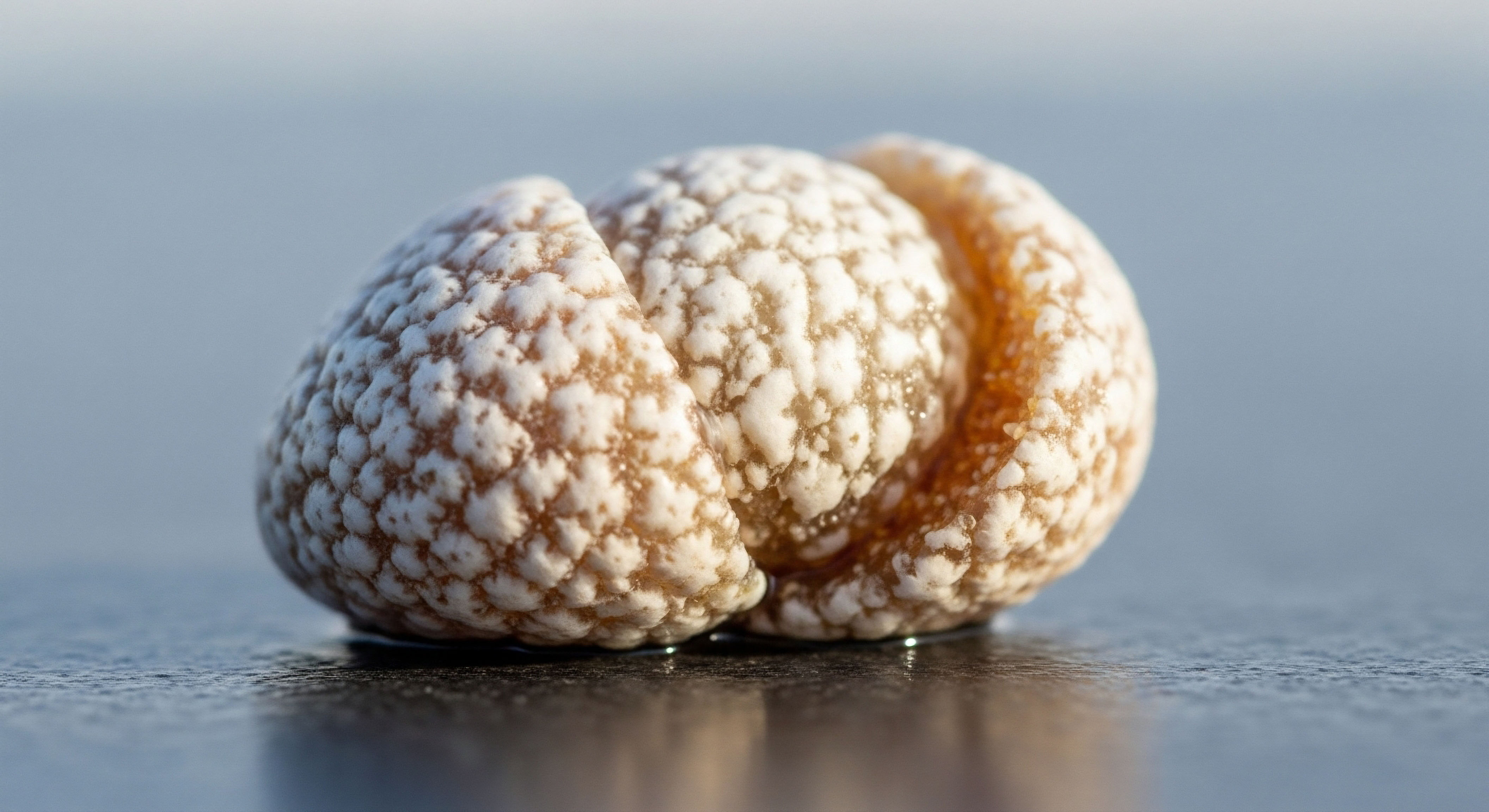

Fundamentals

A Personal Reckoning with Biological Function
The decision to understand and potentially restore one’s reproductive capacity often begins not with a clinical diagnosis, but with a quiet, internal audit. It is a deeply personal inventory of vitality, of function, and of the future.
You may have arrived here after noticing a shift in your own body’s operational baseline, or perhaps after a clinical conversation that introduced terms like ‘secondary hypogonadism’ or ‘impaired spermatogenesis’. This experience, this feeling of a system not running at its peak, is a valid and important starting point.
Your body is a finely tuned biological engine, and its signals are the most important data you possess. The process of creating new life, spermatogenesis, is a testament to this engine’s complexity. It is a continuous, intricate biological manufacturing line that runs within the seminiferous tubules of the testes, taking approximately 74 days from start to finish. This is not a static state but a dynamic process, exquisitely sensitive to the internal environment you create through your daily choices.
Understanding this process begins with acknowledging the command and control system that governs it ∞ the Hypothalamic-Pituitary-Gonadal (HPG) axis. Think of this as the body’s internal communication network dedicated to reproductive health. The hypothalamus, a small region in the brain, acts as the mission controller.
It releases Gonadotropin-Releasing Hormone (GnRH) in carefully timed pulses. These pulses travel to the pituitary gland, the master gland, instructing it to release two critical messenger hormones ∞ Luteinizing Hormone (LH) and Follicle-Stimulating Hormone (FSH). LH travels through the bloodstream to the Leydig cells in the testes, signaling them to produce testosterone.
FSH communicates with the Sertoli cells, the “nurse” cells of the testes, which are directly responsible for nurturing developing sperm cells through their complex stages of maturation. Testosterone, produced by the Leydig cells, is also essential within the testes for this process to succeed, requiring concentrations many times higher than what is found in the bloodstream.
This entire network operates on a sophisticated feedback loop. High levels of testosterone signal the hypothalamus and pituitary to slow down GnRH, LH, and FSH release, maintaining a precise balance. It is a system of profound biological intelligence.

The Architecture of Male Fertility
Spermatogenesis is the biological process that produces mature male gametes. This complex and highly organized sequence of events unfolds within the seminiferous tubules of the testes. The process is initiated at puberty and continues throughout a man’s life, although its efficiency can decline with age and under the influence of various internal and external factors.
The entire cycle, from the initial division of a stem cell to the release of mature spermatozoa, is a lengthy and resource-intensive undertaking for the body. It involves three major phases ∞ mitosis, meiosis, and spermiogenesis. During mitosis, spermatogonial stem cells divide to create a continuous supply of precursor cells.
Following this, meiosis occurs, a specialized type of cell division that reduces the number of chromosomes by half, creating haploid spermatids. The final phase, spermiogenesis, is a dramatic transformation where these simple round cells are sculpted into the familiar shape of a spermatozoon, complete with a head containing the genetic material, a midpiece packed with mitochondria for energy, and a tail for motility.
The successful execution of this complex process depends on a very specific and stable environment within the testes. The Sertoli cells create this specialized environment, forming the blood-testis barrier, which protects the developing sperm cells from the body’s immune system. These cells provide structural support and supply essential nutrients to the germ cells.
The function of Sertoli cells is directly regulated by FSH from the pituitary gland. Simultaneously, the Leydig cells, located in the tissue between the seminiferous tubules, are responsible for producing testosterone under the stimulation of LH.
This intratesticular testosterone is absolutely vital; its concentration within the testes is about 100 times higher than in the blood and is required to drive the developing sperm through to maturity. Any disruption to the function of Sertoli cells, Leydig cells, or the hormonal signals that control them can compromise the entire process of spermatogenesis.
The Hypothalamic-Pituitary-Gonadal axis functions as the central regulating network for male reproductive health, translating brain signals into hormonal actions within the testes.

How Lifestyle Factors Disrupt the System
The elegant balance of the HPG axis and the sensitive environment of the testes are profoundly influenced by lifestyle. These are not abstract risks; they are tangible inputs that directly alter the biochemical and hormonal signaling required for sperm production. Your daily habits are, in effect, a set of instructions you are feeding into this complex system.
Certain instructions can cause significant operational disruptions. For instance, chronic psychological stress activates the body’s primary stress response system, the Hypothalamic-Pituitary-Adrenal (HPA) axis. This leads to the release of cortisol, the primary stress hormone. Elevated cortisol levels can directly suppress the release of GnRH from the hypothalamus, which in turn reduces the output of LH and FSH from the pituitary.
This dampening of the HPG axis leads to lower testosterone production and impaired signaling to the Sertoli cells, creating a suboptimal environment for spermatogenesis.
Similarly, factors that increase the body’s core or scrotal temperature can directly harm sperm development. The scrotum’s position outside the body cavity is a specific evolutionary design to keep the testes 2-4°C cooler than the core body temperature, a critical requirement for viable sperm production.
Activities like frequent use of hot tubs or saunas, or even prolonged sitting with a laptop on your lap, can raise the scrotal temperature enough to induce heat stress on the developing germ cells. This can lead to increased rates of cell death, abnormal sperm morphology, and reduced sperm counts.
Obesity represents another significant lifestyle-related disruption. Excess adipose tissue, particularly visceral fat, functions as an endocrine organ. It increases the activity of the aromatase enzyme, which converts testosterone into estrogen. Higher estrogen levels send a powerful negative feedback signal to the HPG axis, suppressing LH and FSH production and thereby reducing testicular testosterone synthesis. This creates a dual problem ∞ lower testosterone and higher estrogen, a hormonal environment that is unfavorable for robust spermatogenesis.


Intermediate

Recalibrating the System after Hormonal Suppression
For individuals who have used Testosterone Replacement Therapy (TRT) or other anabolic-androgenic steroids (AAS), the body’s natural hormonal production line has been intentionally bypassed. The introduction of exogenous testosterone provides the body with a high level of this hormone from an external source.
The HPG axis, sensing these high levels, responds by shutting down its own production of GnRH, LH, and FSH. This is the body’s natural regulatory mechanism at work. The consequence is that the testes’ Leydig cells are no longer stimulated to produce testosterone, and the Sertoli cells no longer receive the FSH signal needed to support spermatogenesis.
This leads to a decrease or complete cessation of sperm production and often testicular atrophy. When the external source of testosterone is removed, the system does not simply switch back on. The HPG axis has been dormant and requires a period of time and often active intervention to restart. The goal of a recovery protocol is to actively stimulate this axis to resume its natural signaling cascade.
The cornerstone of many recovery protocols involves the use of Selective Estrogen Receptor Modulators (SERMs), such as clomiphene citrate (Clomid) or tamoxifen. These compounds work in a very specific way. They travel to the brain and bind to estrogen receptors in the hypothalamus and pituitary gland.
By occupying these receptors, they block the body’s own estrogen from binding and exerting its negative feedback effect. The brain interprets this blockade as a state of low estrogen, which prompts it to increase the production and release of GnRH. This, in turn, stimulates the pituitary to secrete more LH and FSH.
The renewed surge of LH travels to the Leydig cells, instructing them to begin producing testosterone again. The increase in FSH stimulates the Sertoli cells, preparing the testicular environment for the resumption of spermatogenesis. This process effectively “jump-starts” the entire HPG axis from the top down.

Pharmacological Tools for Spermatogenesis Recovery
While SERMs work by stimulating the top of the HPG axis, other agents can be used to directly stimulate the testes. Human Chorionic Gonadotropin (hCG) is a hormone that is structurally very similar to LH. Because of this similarity, it can bind to and activate the LH receptors on the Leydig cells in the testes.
This provides a powerful, direct signal for the testes to produce testosterone, even if the pituitary is not yet producing sufficient LH on its own. This action helps to increase intratesticular testosterone levels, which are critical for spermatogenesis, and can also help reverse the testicular atrophy that often occurs with testosterone suppression. hCG is often used in recovery protocols, sometimes in combination with SERMs, to provide a multi-pronged approach to restarting the system.
Another tool is Gonadorelin, which is a synthetic version of GnRH. By administering Gonadorelin, one can directly stimulate the pituitary gland to release LH and FSH. This can be particularly useful for ensuring the pituitary remains responsive and ready to function as the hypothalamus begins its own recovery.
It is often administered in a pulsatile fashion to mimic the body’s natural GnRH release, which can help maintain the sensitivity of the pituitary receptors. The choice between these agents ∞ SERMs, hCG, Gonadorelin ∞ or their combination depends on the individual’s specific situation, including the duration of suppression, baseline hormone levels, and the clinical goals.
For example, a protocol might start with hCG to directly stimulate the testes and then add a SERM like clomiphene citrate to encourage the entire HPG axis to come back online for long-term, sustainable function.

Comparing Recovery Agents
The selection of a specific pharmacological agent or combination of agents for a spermatogenesis recovery protocol is based on their distinct mechanisms of action within the HPG axis. Understanding these differences is key to appreciating the strategy behind a personalized treatment plan.
| Agent | Primary Mechanism of Action | Target Organ | Primary Hormonal Effect |
|---|---|---|---|
| Clomiphene Citrate (SERM) | Blocks estrogen receptors in the brain, preventing negative feedback. | Hypothalamus & Pituitary Gland | Increases endogenous GnRH, LH, and FSH secretion. |
| Human Chorionic Gonadotropin (hCG) | Mimics the action of LH, directly stimulating the testes. | Testes (Leydig Cells) | Increases intratesticular and serum testosterone production. |
| Gonadorelin (GnRH Analog) | Mimics the action of GnRH, directly stimulating the pituitary. | Pituitary Gland | Stimulates the release of LH and FSH. |
| Anastrozole (Aromatase Inhibitor) | Blocks the conversion of testosterone to estrogen in peripheral tissues. | Adipose Tissue, Liver, etc. | Lowers overall estrogen levels, reducing negative feedback. |

The Foundational Role of Lifestyle Modification
Pharmacological interventions are powerful tools for restarting a suppressed system, but their success is profoundly influenced by the underlying biological environment. Lifestyle factors are the architects of this environment. A recovery protocol undertaken in the context of a healthy lifestyle is far more likely to be successful and sustainable. Nutrition, for example, provides the essential raw materials for both hormone production and sperm development. The process of spermatogenesis is metabolically demanding and requires a steady supply of specific micronutrients.
- Zinc ∞ This trace mineral is found in high concentrations in the testes and is a critical cofactor for over 300 enzymes in the body, including those involved in testosterone synthesis and sperm maturation. Zinc deficiency has been linked to impaired spermatogenesis and lower testosterone levels.
- Selenium ∞ An essential component of several key antioxidant enzymes called selenoproteins, which protect developing sperm cells from oxidative damage. Selenium is vital for maintaining the structural integrity of the sperm flagellum (tail).
- Antioxidant Vitamins (C and E) ∞ Sperm cells are particularly vulnerable to damage from reactive oxygen species (ROS), a byproduct of normal metabolism. Vitamins C and E are powerful antioxidants that neutralize ROS in the seminal plasma and within the cells, protecting sperm DNA and membrane integrity.
- Omega-3 Fatty Acids ∞ The membranes of sperm cells are rich in polyunsaturated fatty acids, particularly DHA. These fats are crucial for membrane fluidity, which is essential for the acrosome reaction and fertilization.
A diet rich in whole foods, including fruits, vegetables, lean proteins, and healthy fats, provides these necessary building blocks. Conversely, a diet high in processed foods, sugar, and unhealthy fats can promote inflammation and oxidative stress, actively working against the goals of the recovery protocol.
Pharmacological recovery protocols act as a catalyst, but a foundation of strategic nutrition and managed stress determines the ultimate success and stability of the restored system.

Exercise and Stress the Double-Edged Swords
Physical activity is another critical lifestyle lever. Regular, moderate-intensity exercise has been shown to improve insulin sensitivity, reduce inflammation, and support healthy testosterone levels. It can also be an effective tool for managing stress. However, the intensity and duration of exercise matter immensely.
Overtraining or engaging in excessively high-intensity exercise for prolonged periods can have the opposite effect. It can increase cortisol levels, generate excessive oxidative stress, and suppress the HPG axis, thereby hindering recovery. The key is finding a sustainable balance. Activities like brisk walking, jogging, swimming, and resistance training performed 3-5 times per week are generally beneficial.
Managing psychological stress is equally important. As previously discussed, chronic stress leads to elevated cortisol, which directly antagonizes the HPG axis. Implementing stress-reduction techniques is not a passive recommendation; it is an active part of a clinical protocol.
Practices such as mindfulness meditation, deep breathing exercises, and ensuring adequate sleep can help lower cortisol levels and shift the nervous system from a “fight-or-flight” state to a “rest-and-digest” state. Sleep is particularly critical, as the majority of testosterone release occurs during deep sleep.
Consistently poor sleep quality or quantity disrupts this natural rhythm and can significantly impair hormonal recovery. A successful recovery protocol, therefore, integrates pharmacology with a conscious and deliberate restructuring of these fundamental lifestyle pillars.


Academic

The Centrality of Oxidative Stress in Spermatogenesis Impairment
At a molecular level, a unifying mechanism that links many lifestyle-related insults to impaired spermatogenesis is oxidative stress. This condition arises from an imbalance between the production of reactive oxygen species (ROS) and the body’s ability to neutralize them with its antioxidant defense systems.
While physiological levels of ROS are necessary for certain sperm functions like capacitation and the acrosome reaction, excessive levels are highly detrimental. Spermatozoa are uniquely vulnerable to oxidative damage. Their plasma membranes are rich in polyunsaturated fatty acids, which are highly susceptible to lipid peroxidation by ROS.
This process can damage the membrane’s integrity, impairing motility and the sperm’s ability to fuse with an oocyte. Furthermore, the cytoplasm of a mature spermatozoon is minimal, meaning it has very limited intrinsic antioxidant enzyme systems to protect itself.
Perhaps the most significant consequence of oxidative stress is damage to sperm DNA. ROS can cause breaks in the DNA strands and induce chemical modifications to the DNA bases. This damage, known as high sperm DNA fragmentation, is a major contributor to male infertility.
While the oocyte has some capacity to repair damaged sperm DNA after fertilization, extensive damage can overwhelm these repair mechanisms, leading to failure of fertilization, poor embryo development, or early pregnancy loss. Lifestyle factors are major drivers of systemic oxidative stress.
Smoking, excessive alcohol consumption, obesity, and exposure to environmental toxins all increase the body’s ROS load, while a poor diet can deplete its antioxidant reserves. Therefore, a clinical approach to restoring spermatogenesis must include strategies to mitigate oxidative stress at its source.

Metabolic Health as the Bedrock of the HPG Axis
The conversation about hormonal health and fertility is inseparable from the conversation about metabolic health. The endocrine system does not operate in a vacuum; it is deeply intertwined with the body’s metabolic machinery, particularly the regulation of insulin and glucose.
Insulin resistance, a condition often preceding type 2 diabetes and commonly associated with obesity and a sedentary lifestyle, has profound negative implications for the HPG axis. In a state of insulin resistance, the body’s cells do not respond effectively to insulin, leading to higher circulating levels of both insulin (hyperinsulinemia) and glucose. This metabolic dysregulation can disrupt male reproductive function through several pathways.
Hyperinsulinemia can directly affect the pituitary gland, potentially altering the pulsatility of LH release. Furthermore, the chronic low-grade inflammation that accompanies insulin resistance and obesity contributes to systemic oxidative stress, which, as discussed, is directly toxic to sperm.
The increased aromatase activity in the excess adipose tissue of obese individuals further skews the testosterone-to-estrogen ratio, suppressing HPG axis function. Correcting insulin resistance through dietary modification (such as reducing intake of refined carbohydrates and sugars) and regular physical activity can therefore have a powerful, positive effect on the hormonal environment.
Improving insulin sensitivity can help normalize the testosterone-to-estrogen ratio, reduce inflammation, and lower oxidative stress, thereby creating a more favorable foundation for both natural and pharmacologically-assisted spermatogenesis recovery.
The integrity of sperm DNA is a direct reflection of the body’s systemic balance between oxidative damage and antioxidant defense, a balance heavily influenced by daily metabolic inputs.

What Is the Molecular Link between Diet and Sperm Epigenetics?
Emerging research is revealing that the influence of lifestyle, particularly diet, extends beyond simple nutrient provision and into the realm of epigenetics. Epigenetics refers to modifications to DNA that do not change the DNA sequence itself but alter gene activity.
These modifications, such as DNA methylation and histone modification, act as a layer of control, switching genes on or off. The epigenetic patterns in sperm are critical for proper embryonic development. Paternal diet can influence these epigenetic marks. For example, the availability of certain nutrients, such as folate, vitamin B12, and zinc, which are involved in one-carbon metabolism, is essential for the proper establishment and maintenance of DNA methylation patterns during spermatogenesis.
An unhealthy paternal diet, such as one high in fat and sugar, has been shown in animal models to alter the epigenetic signature of sperm, and these altered patterns can be passed on to the offspring, potentially programming them for an increased risk of metabolic diseases later in life.
This adds another layer of significance to preconception health. Lifestyle interventions are not only about improving fertility parameters for conception; they are also about optimizing the epigenetic health of the sperm to support the long-term health of the next generation. The use of specific bioactive food compounds and antioxidants may help protect the sperm epigenome from the damaging effects of oxidative stress and inflammation.

Key Nutritional Cofactors in Spermatogenesis
The biochemical pathways supporting sperm production and hormonal balance are dependent on a consistent supply of specific micronutrients that act as enzymatic cofactors and structural components. Deficiencies in these key areas can create significant bottlenecks in the system.
| Nutrient/Compound | Primary Role in Male Reproductive Health | Common Dietary Sources |
|---|---|---|
| Zinc | Cofactor for testosterone production; essential for sperm cell division and maturation. | Oysters, beef, pumpkin seeds, lentils. |
| Selenium | Integral part of antioxidant selenoproteins (e.g. GPX4) that protect sperm from oxidative damage; required for tail integrity. | Brazil nuts, tuna, sardines, beef, turkey. |
| Folate (Vitamin B9) | Essential for DNA synthesis and repair; crucial for preventing chromosomal abnormalities in sperm. | Leafy greens (spinach, kale), lentils, asparagus, broccoli. |
| Coenzyme Q10 | Functions in the mitochondrial electron transport chain for ATP production; acts as a potent antioxidant in seminal fluid. | Organ meats (heart, liver), fatty fish (tuna, herring), beef, spinach. |
| L-Carnitine | Transports fatty acids into the mitochondria for energy production; critical for sperm motility. | Beef, pork, chicken, milk. |
| Omega-3 Fatty Acids (DHA/EPA) | Structural component of sperm cell membranes, influencing fluidity and fertilization capacity. | Fatty fish (salmon, mackerel, sardines), walnuts, chia seeds. |

References
- Sharpe, R. M. (2010). Environmental/lifestyle effects on spermatogenesis. Philosophical Transactions of the Royal Society B ∞ Biological Sciences, 365(1546), 1697 ∞ 1712.
- Wenker, E. P. et al. (2015). The Use of HCG-Based Combination Therapy for Recovery of Spermatogenesis after Testosterone Use. The Journal of Sexual Medicine, 12(6), 1334-1337.
- Gabrielsen, J. S. & Tanrikut, C. (2016). Recovery of spermatogenesis following testosterone replacement therapy or anabolic-androgenic steroid use. Asian Journal of Andrology, 18(3), 371 ∞ 376.
- Ilacqua, A. et al. (2018). The impact of lifestyle and diet on male fertility. Andrology, 6(5), 665-673.
- Cheah, Y. & Yang, W. (2011). Functions of essential nutrition for high quality spermatogenesis. Advances in Bioscience and Biotechnology, 2(4), 182-197.
- Durairajanayagam, D. (2018). Lifestyle causes of male infertility. Arab Journal of Urology, 16(1), 10-20.
- Skoracka, K. et al. (2021). Diet and Nutritional Factors in Male (In)fertility ∞ Underestimated Factors. Journal of Clinical Medicine, 10(5), 1000.
- Dutta, S. et al. (2019). The Impact of Oxidative Stress in Male Infertility. Frontiers in Molecular Biosciences, 6, 139.
- Abedpoor, N. et al. (2024). Exploring the dynamics of exercise intensity on male fertility and reproductive health ∞ advancements and implications for fertility research. Journal of Ovarian Research, 17(1), 1-15.
- Kim, E. D. et al. (2013). Enclomiphene citrate stimulates testosterone production while preventing oligospermia ∞ a randomized phase II clinical trial comparing topical testosterone. Fertility and Sterility, 100(3), 720-727.

Reflection

The Path Forward Is a Personal Equation
The information presented here offers a map of the complex biological territory governing male fertility. It details the communication networks, the cellular machinery, and the external factors that influence its operation. This knowledge provides a framework for understanding your own body’s signals and the clinical logic behind potential interventions.
The path to optimizing any biological system, however, is not found on a generic map. It is discovered through a process of personalized investigation. Your unique history, your specific metabolic and hormonal status, and your individual life circumstances all form the variables in a personal health equation.
Viewing your body as a system you can interact with and support is a powerful shift in perspective. The journey begins with a comprehensive assessment of where your system currently stands, often through detailed lab work and a thorough clinical evaluation. This provides the baseline data needed to make informed decisions.
The subsequent steps, whether they involve targeted nutritional strategies, specific stress management techniques, or a clinically guided recovery protocol, are all inputs designed to recalibrate your unique system. The ultimate goal is to move beyond simply addressing symptoms and toward restoring the underlying function and resilience of the system as a whole. This process is a partnership between you and your clinical guide, grounded in scientific principles but executed with a deep respect for your individual biology.



